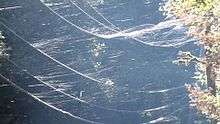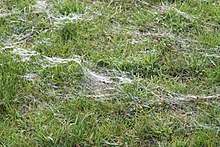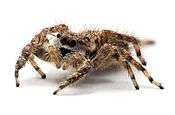Ballooning (spider)
Ballooning, sometimes called kiting, is a process by which spiders, and some other small invertebrates, move through the air by releasing one or more gossamer threads to catch the wind, causing them to become airborne at the mercy of air currents and potentially electric currents. This is primarily used by spiderlings to disperse; however, larger individuals have been observed doing so as well. The spider climbs to a high point and takes a stance with its abdomen to the sky, releasing fine silk threads from its spinneret until it becomes aloft. Journeys achieved vary from a few metres to hundreds of kilometres. Even atmospheric samples collected from balloons at five kilometres altitude and ships mid-ocean have reported spider landings. Mortality is high.[1]

It is observed in many species of spiders, as well as in spider mites (Tetranychidae) and in 31 species of lepidoptera, distributed in 8 suborders. Bell and his colleagues put forward the hypothesis that ballooning first appeared in the Cretaceous.[2]
Description
Ballooning is a behaviour in which spiders and some other invertebrates use airborne dispersal to move between locations.[3][4] A spider (usually limited to individuals of a small species), or spiderling after hatching,[5] will climb as high as it can, stand on raised legs with its abdomen pointed upwards ("tiptoeing"),[6] and then release several silk threads from its spinnerets into the air. These automatically form a triangular shaped parachute[7] which carries the spider away on updrafts of winds where even the slightest of breezes will disperse the arachnid.[6][7] The Earth's static electric field may also provide lift in windless conditions.[8] Ballooning behavior may be triggered by favorable electric fields.[9][10]
Many spiders use especially fine silk called gossamer[11] to lift themselves off a surface, and silk also may be used by a windblown spider to anchor itself to stop its journey.[7] The term "gossamer" is used metaphorically for any exceedingly fine thread or fabric. Biologists also apply the term "balloon silk" to the threads that mechanically lift and drag systems.
It is generally thought that most spiders heavier than 1 mg are unlikely to use ballooning.[12] Because many individuals die during ballooning, it is less likely that adults will balloon compared to spiderlings. However, adult females of several social Stegodyphus species (S. dumicola and S. mimosarum) weighing more than 100 mg and with a body size of up to 14 millimetres (0.55 in) have been observed ballooning using rising thermals on hot days without wind. These spiders use tens to hundreds of silk strands, which form a triangular sheet with a length and width of about 1 metre (39 in).[7]
In Australia, in 2012 and in May 2015, millions of spiders were reported to have ballooned into the air, making the ground where they landed seem snow-covered with their silk.[13]
Distance and height achieved

Most ballooning journeys end after just a few meters of travel, although depending on the spider's mass and posture,[14] a spider might be taken up into a jet stream. The trajectory further depends on the convection air currents and the drag of the silk and parachute to float and travel high up into the upper atmosphere.[15]
Many sailors have reported spiders being caught in their ship's sails over 1,600 kilometres (990 mi)[16] from land (Heimer 1988). They have even been detected in atmospheric data balloons collecting air samples at slightly less than 5 kilometres (16,000 ft) above sea level.[17] Evidently, ballooning is the most common way for spiders to invade isolated islands and mountaintops.[16][18] Spiderlings are known to survive without food while travelling in air currents of jet streams for 25 days or longer.[4]
Some mites and some caterpillars also use silk to disperse through the air.
A close association has been found between ballooning behaviors and the ability for a species of spiders to survive afloat on water. Water-repellent legs keep them alive on both fresh and salt water, enabling them to survive waves up to 0.5 metres in height. In wind many species raised their legs or abdomens to use as sails, propelling themselves across the water's surface. Many species of spiders also drop silk to anchor themselves in place while afloat. Said spiders did not show these behaviours on land, suggesting that they are adaptations to water.[19][20][21]
History
Although this phenomenon has been known since the time of Aristotle , the first precise observations were published by the arachnologist John Blackwall in 1827. Several studies have since made it possible to analyze this behavior.
See also
- Charlotte's Web
- Aeroplankton
- "A Noiseless Patient Spider", a poem by Walt Whitman based on spider ballooning behaviour
- Organisms at high altitude
- Spider silk
References
- Morley, Erica L.; Robert, Daniel (July 2018). "Electric Fields Elicit Ballooning in Spiders". Current Biology. 28 (14): 2324–2330.e2. doi:10.1016/j.cub.2018.05.057. PMC 6065530. PMID 29983315.
- Bell, JR, DA Bohan, EM Shaw & GS Weyman. 2005. Ballooning dispersal using silk: world fauna, phylogenies, genetics and models [ archive ] . Bulletin of Entomological Research 95: 69-114.
- Heinrichs, Ann (2004). Spiders. Compass Point Books. ISBN 9780756505905. OCLC 54027960.
- Valerio, C.E. (1977). "Population structure in the spider Achaearranea Tepidariorum (Aranae, Theridiidae)". Journal of Arachnology. 3 (3): 185–190. JSTOR 3704941.
- Bond, Jason Edward (22 September 1999). Systematics and Evolution of the Californian Trapdoor Spider Genus Aptostichus Simon (Araneae: Mygalomorphae: Euctenizidae) (Thesis). CiteSeerX 10.1.1.691.8754. hdl:10919/29114.
- Weyman, G.S. (1995). "Laboratory studies of the factors stimulating ballooning behavior by Linyphiid spiders (Araneae, Linyphiidae)". Journal of Arachnology. 23 (2): 75–84. JSTOR 3705494.
- Schneider, J.M.; Roos, J.; Lubin, Y.; Henschel, J.R. (October 2001). "Dispersal of Stegodyphus Dumicola (Araneae, Eresidae): They do balloon after all!". Journal of Arachnology. 29 (1): 114–116. doi:10.1636/0161-8202(2001)029[0114:DOSDAE]2.0.CO;2.
- Gorham, Peter (Sep 2013). "Ballooning spiders: The case for electrostatic flight". arXiv:1309.4731 [physics.bio-ph].
- Morley, Erica L.; Robert, Daniel (5 July 2018). "Electric Fields Elicit Ballooning in Spiders". Current Biology. 28 (14): 2324–2330.e2. doi:10.1016/j.cub.2018.05.057. PMC 6065530. PMID 29983315.
- Young, Ed (5 July 2018). "Spiders Can Fly Hundreds of Miles Using Electricity". The Atlantic. Retrieved 5 July 2018.
- Oxford English Dictionary 2nd ed.: Gossamer, noun and adjective: fine filmy substance, consisting of cobwebs, spun by small spiders, which is seen floating in the air in calm weather, esp. in autumn, or spread over a grassy surface: occas. with a and pl., a thread or web of gossamer.
- Suter, R.B. (1999). "An aerial lottery: The physics of ballooning in a chaotic atmosphere". Journal of Arachnology. 27 (1): 281–293. JSTOR 3705999.
- Dell'Amore, Christine; 18, National Geographic PUBLISHED May. "Millions of Spiders Rain Down on Australia—Why?". National Geographic News. Retrieved 2015-05-19.CS1 maint: numeric names: authors list (link)
- Suter, R.B. (1992). "Ballooning: Data from spiders in freefall indicate the importance of posture". Journal of Arachnology. XX (2): 107–113. JSTOR 3705774.
- Greenstone, M.H.; Morgan, C.E.; Hultsh, A.-L. (1987). "Ballooning spiders in Missouri, USA, and New South Wales, Australia: Family and mass distributions". Journal of Arachnology. 15 (2): 163–170. JSTOR 3705725.
- Hormiga, G. (2002). "Orsonwells, a new genus of giant linyphild spiders (Araneae) from the Hawaiian Islands". Invertebrate Systematics. 16 (3): 369–448. doi:10.1071/IT01026.
- VanDyk, J.K. (2002–2009). "Entomology 201 - Introduction to insects". Department of Entomology, Iowa State University. Archived from the original on 8 June 2009. Retrieved 18 July 2009.
- Bilsing, S.W. (May 1920). "Quantitative studies in the food of spiders". The Ohio Journal of Science. 20 (7): 215–260. hdl:1811/867.
- Hayashi, Morito; Bakkali, Mohammed; Hyde, Alexander; Goodacre, Sara L. (3 July 2015). "Sail or sink: novel behavioural adaptations on water in aerially dispersing species". BMC Evolutionary Biology. 15 (1): 118. doi:10.1186/s12862-015-0402-5. PMC 4490750. PMID 26138616.
- Cressey, Daniel (3 July 2015). "Airborne spiders can sail on seas". Nature. doi:10.1038/nature.2015.17906.
- "Flying spiders also sail on water". Nature. 523 (7559): 130–131. 8 July 2015. doi:10.1038/523130d.
Further reading
- Dean, D. A.; Sterling, W. L. (1985). "Size and Phenology of Ballooning Spiders at Two Locations in Eastern Texas". The Journal of Arachnology. 13 (1): 111–120. JSTOR 3705236.</ref>
- Heimer, S. (1988): Wunderbare Welt der Spinnen. Urania-Verlag Leipzig. ISBN 3-332-00210-4.
